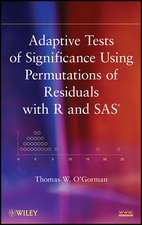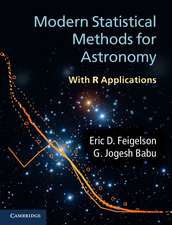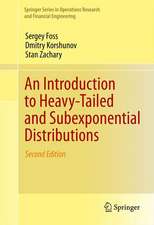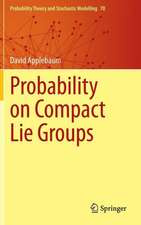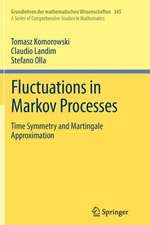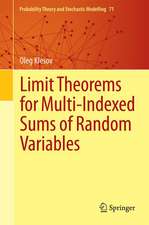Introduction to Probability and Statistics for Engineers
Autor Milan Holickýen Limba Engleză Hardback – 20 aug 2013
The book sets out fundamental principles of the probability theory, supplemented by theoretical models of random variables, evaluation of experimental data, sampling theory, distribution updating and tests of statistical hypotheses. Basic concepts of Bayesian approach to probability and two-dimensional random variables, are also covered. Examples of reliability analysis and risk assessment of technological systems are used throughout the book to illustrate basic theoretical concepts and their applications.
The primary audience for the book includes undergraduate and graduate students of science and engineering, scientific workers and engineers and specialists in the field of reliability analysis and risk assessment. Except basic knowledge of undergraduate mathematics no special prerequisite is required.
| Toate formatele și edițiile | Preț | Express |
|---|---|---|
| Paperback (1) | 382.18 lei 6-8 săpt. | |
| Springer Berlin, Heidelberg – 27 aug 2015 | 382.18 lei 6-8 săpt. | |
| Hardback (1) | 498.94 lei 6-8 săpt. | |
| Springer Berlin, Heidelberg – 20 aug 2013 | 498.94 lei 6-8 săpt. |
Preț: 498.94 lei
Preț vechi: 586.98 lei
-15% Nou
Puncte Express: 748
Preț estimativ în valută:
95.48€ • 103.68$ • 80.21£
95.48€ • 103.68$ • 80.21£
Carte tipărită la comandă
Livrare economică 22 aprilie-06 mai
Preluare comenzi: 021 569.72.76
Specificații
ISBN-13: 9783642382994
ISBN-10: 3642382991
Pagini: 200
Ilustrații: X, 181 p.
Dimensiuni: 155 x 235 x 17 mm
Greutate: 0.41 kg
Ediția:2013
Editura: Springer Berlin, Heidelberg
Colecția Springer
Locul publicării:Berlin, Heidelberg, Germany
ISBN-10: 3642382991
Pagini: 200
Ilustrații: X, 181 p.
Dimensiuni: 155 x 235 x 17 mm
Greutate: 0.41 kg
Ediția:2013
Editura: Springer Berlin, Heidelberg
Colecția Springer
Locul publicării:Berlin, Heidelberg, Germany
Public țintă
Upper undergraduateCuprins
Foreword.- 1 Introduction.- 2.Basic Concepts of Probability.- 3.Evaluation of Statistical Data.- 4.Distributions of Random Variables.- 5.Selected Models of Discrete Variables.- 6.Selected Models of Continuous Variables.- 7.Functions of Random Variables.- 8.Estimations of the Population Parameters.- 9.Fractiles of Random Variables.- 10.Testing of Statistical Hypotheses.- 11.Correlation and Regression.- 12.Random Functions.- Appendixes.
Recenzii
From the reviews:
“This work … primarily covers fundamental topics in statistics such as probability, descriptive statistics and higher moments, selected discrete and continuous random variables, parameter estimation, hypothesis testing of sample means and variances, and correlation and simple linear regression. … This concise book may be suitable for engineers and practitioners who already have knowledge of mathematical statistics in order to refresh their memory. Summimg Up … Professionals/practitioners.” (S-T. Kim, Choice, Vol. 51 (7), March, 2014)
“This work … primarily covers fundamental topics in statistics such as probability, descriptive statistics and higher moments, selected discrete and continuous random variables, parameter estimation, hypothesis testing of sample means and variances, and correlation and simple linear regression. … This concise book may be suitable for engineers and practitioners who already have knowledge of mathematical statistics in order to refresh their memory. Summimg Up … Professionals/practitioners.” (S-T. Kim, Choice, Vol. 51 (7), March, 2014)
Notă biografică
Prof. Dr. Milan Holický got his civil engineering degree at the Czech Technical University in Prague, and doctor degree at the University of Waterloo, Canada. He is involved in the research of structural reliability and risk assessment. In 2010 he became Extraordinary Professor at the University of Stellenbosch, South Africa; in 2011 he was awarded the degree Honorary Doctor of Science and Engineering of Moscow State University of Civil Engineering.
Textul de pe ultima copertă
The theory of probability and mathematical statistics is becoming an indispensable discipline in many branches of science and engineering. This is caused by increasing significance of various uncertainties affecting performance of complex technological systems. Fundamental concepts and procedures used in analysis of these systems are often based on the theory of probability and mathematical statistics.
The book sets out fundamental principles of the probability theory, supplemented by theoretical models of random variables, evaluation of experimental data, sampling theory, distribution updating and tests of statistical hypotheses. Basic concepts of Bayesian approach to probability and two-dimensional random variables, are also covered. Examples of reliability analysis and risk assessment of technological systems are used throughout the book to illustrate basic theoretical concepts and their applications.
The primary audience for the book includes undergraduate and graduate students of science and engineering, scientific workers and engineers and specialists in the field of reliability analysis and risk assessment. Except basic knowledge of undergraduate mathematics no special prerequisite is required.
The book sets out fundamental principles of the probability theory, supplemented by theoretical models of random variables, evaluation of experimental data, sampling theory, distribution updating and tests of statistical hypotheses. Basic concepts of Bayesian approach to probability and two-dimensional random variables, are also covered. Examples of reliability analysis and risk assessment of technological systems are used throughout the book to illustrate basic theoretical concepts and their applications.
The primary audience for the book includes undergraduate and graduate students of science and engineering, scientific workers and engineers and specialists in the field of reliability analysis and risk assessment. Except basic knowledge of undergraduate mathematics no special prerequisite is required.
Caracteristici
A concise guide on practical applications of probabilistic concepts in engineering Includes a number of instructive examples and exercises For undergraduate and graduate students









